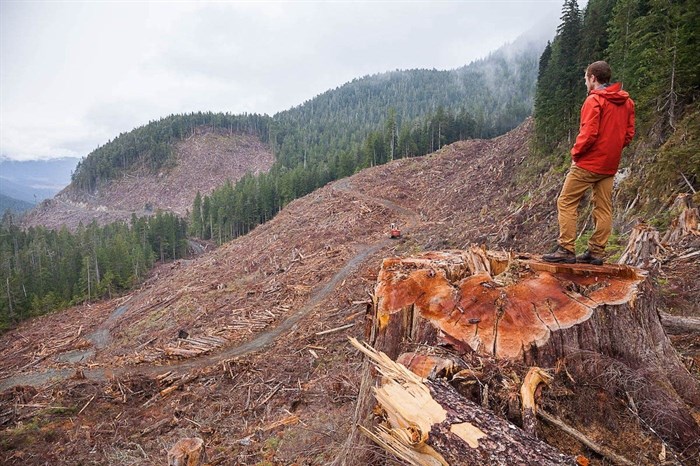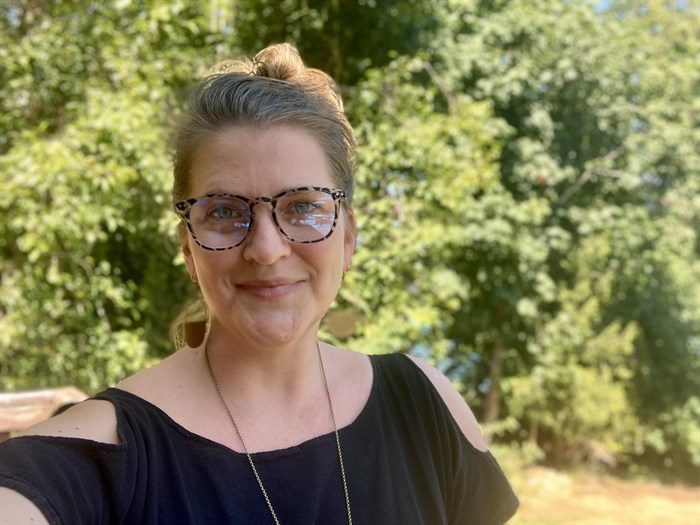
Forest Eye, an online mapping tool, will help the public to monitor old growth logging in B.C. which often takes place in remote locations.
Image Credit: Ancient Forest Alliance/TJ Watt
July 22, 2023 - 4:30 PM
There will soon be no way for old-growth logging to go undetected in B.C.
An online tracking system developed by an international environmental group goes live today. It will enable the public to monitor where old growth is being logged and is designed to hold the province accountable for promises to reform forestry, said project lead Angeline Robertson, a senior investigative researcher with Stand.earth.
Forest Eye — an online mapping system and database developed by Stand.earth — employs satellite imagery, remote sensing technology and government data to detect and alert users to logging and road-building in the most at-risk old-growth forests in the province, Robertson said.
The mapped logging alerts will pinpoint old-growth logging two to four weeks after it begins, identifying where, when and how much was cut and by which private forestry company, Robertson said.
Most importantly, the Forest Eye will also determine if the destruction of old-growth forests occurred in areas considered for logging deferrals since 2020, when the B.C. government committed to transforming its approach to forestry and meeting the independent old-growth strategic review’s recommendations, she said.
“This tool is about revealing the actual mechanics of the [deferral] process and what it has actually meant on the ground,” Robertson said.

Angeline Robertson, project lead for Stand.earth's Forest Eye, says the online tool will allow the public to watchdog old-growth logging.
Image Credit: SUBMITTED
Those old-growth review recommendations centred on immediately deferring logging in the most biologically diverse at-risk areas, protecting more massive trees while working with and involving First Nations and communities in forestry decisions, and improving public information and reporting in the industry.
Conservation groups have criticized the province’s deferral process so far, saying it hasn’t revealed how much of the 2.6 million hectares of the most valuable old growth identified in 2021 for urgent deferrals remains standing, or where and how much has been logged since promised change almost three years ago.
Given the province has failed to provide transparent and reliable information on the state of old growth, Forest Eye can empower people, First Nations, communities and groups to keep a watch on the areas in B.C. that matter most to them, Robertson said.
Site users can subscribe to get alerts or updates about activity in their areas of interest sent directly to them by email or text.
“It provides insight into what's occurring and the timing of [logging], and can offer communities the opportunity to steward what forestry management should look like.”
The province says it has deferred logging in approximately 2.1 million hectares of old growth, but that doesn’t mean the deferrals overlap with the priority areas identified two years ago, Roberson said, adding satellite images and reports from groups, communities and First Nations inspecting on-site operations suggest logging is steadily taking place in those key areas.
“The problem has always been that the government hasn't provided maps of actually showing what areas are being deferred,” she said.
“There's a lot of tall talk from the government. But actually, what we're seeing on the ground is a lot of opportunity for forestry companies to still get out the wood they planned [to harvest].”
Forest Eye’s soft launch this week will include approximately 160 alerts that are already mapped out and about 400 more in the pipeline for analysis and confirmation before being posted to the online system that’s been in testing since March, Robertson said.
Forest Eye has detected more than 4,000 hectares of old-growth logging since January 2020, with upwards of 2,600 hectares occurring in proposed deferral logging areas, she said.
Half of the amount of the potential deferral areas logged has occurred since Premier David Eby pledged to “accelerate” action on old growth in the first 100 days of him becoming leader in November, Robertson said.
The Union of B.C. Indian Chiefs (UBCIC) has repeatedly urged the province to meet its commitment to protect the most rare and at-risk old-growth forest and stop deceiving the public about the amount of logging that continues in proposed deferral areas, Grand Chief Stewart Phillip and UBCIC president in a statement.
“Tensions are rising in the face of climate change. Our forests are on fire and each passing day is breaking worldwide heat records,” said Phillip, noting 1.4 million hectares of forest have been consumed by flames in B.C. alone.
Colonial and industrial greed must give way to greater protections for trees and the planet or catastrophic consequences will result, he said, noting Forest Eye surveillance will improve transparency and accountability.
Robertson was critical of B.C.’s purported efforts to increase transparency on logging operations — noting the province could easily devise and operate a public system similar to Forest Eye, and one that could also compile corporate logging proposals to help identify vital deferral areas before they are destroyed.
“A lot of our data comes from the government,” Roberston said.
“What they provide publicly is not the fulsome dataset they probably have internally, so they could do this better.”
— This story was originally published by Canada’s National Observer.
News from © iNFOnews, 2023